Biophysical and Psychological Processes in Dementia Patients: Case Studies and Care Priorities
VerifiedAdded on 2023/06/03
|8
|2618
|479
AI Summary
This article discusses the biophysical and psychological processes in dementia patients through three case studies. It also identifies appropriate assessment tools and priorities of care for such patients. Additionally, equity issues related to dementia care are also discussed.
Contribute Materials
Your contribution can guide someone’s learning journey. Share your
documents today.
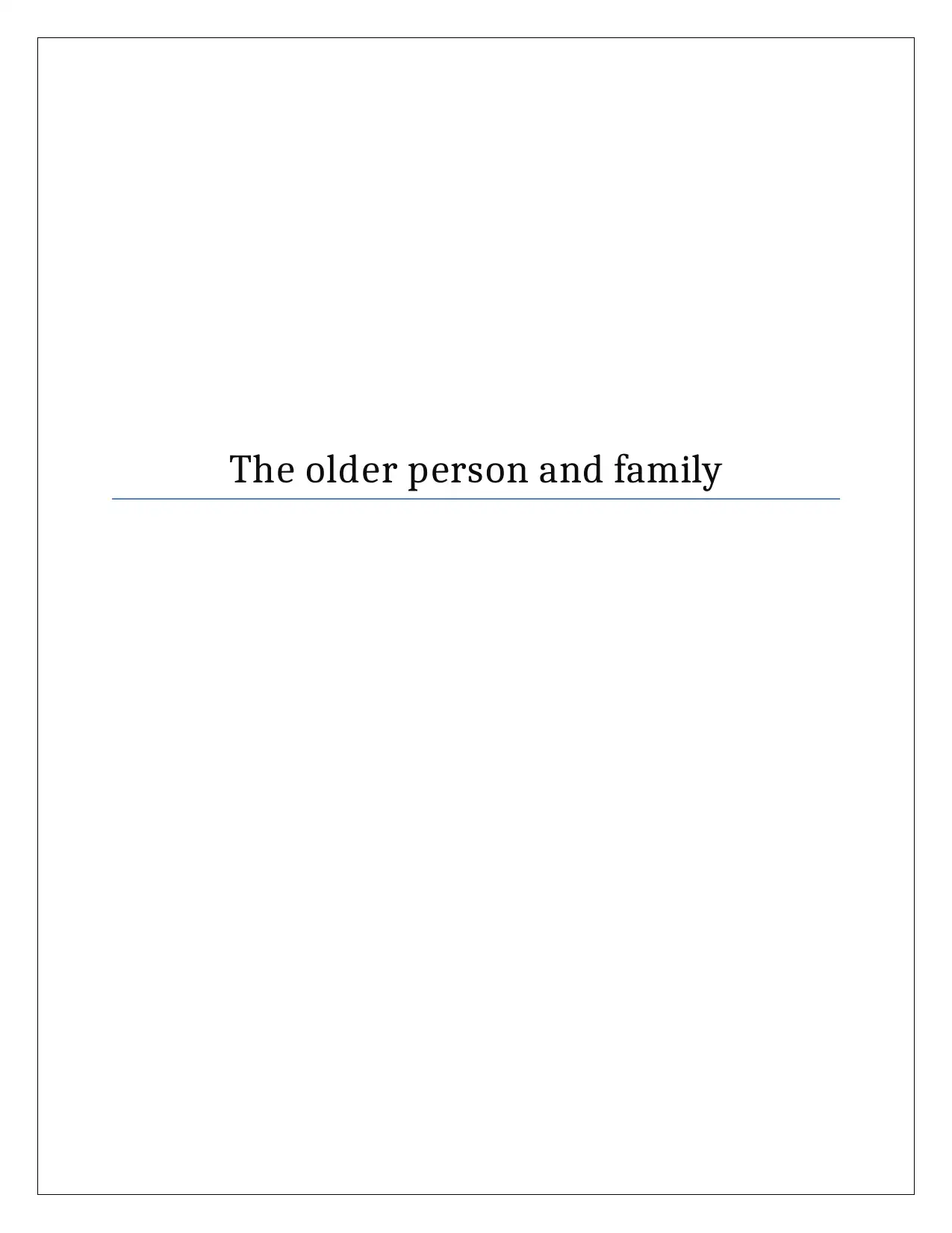
The older person and family
Secure Best Marks with AI Grader
Need help grading? Try our AI Grader for instant feedback on your assignments.
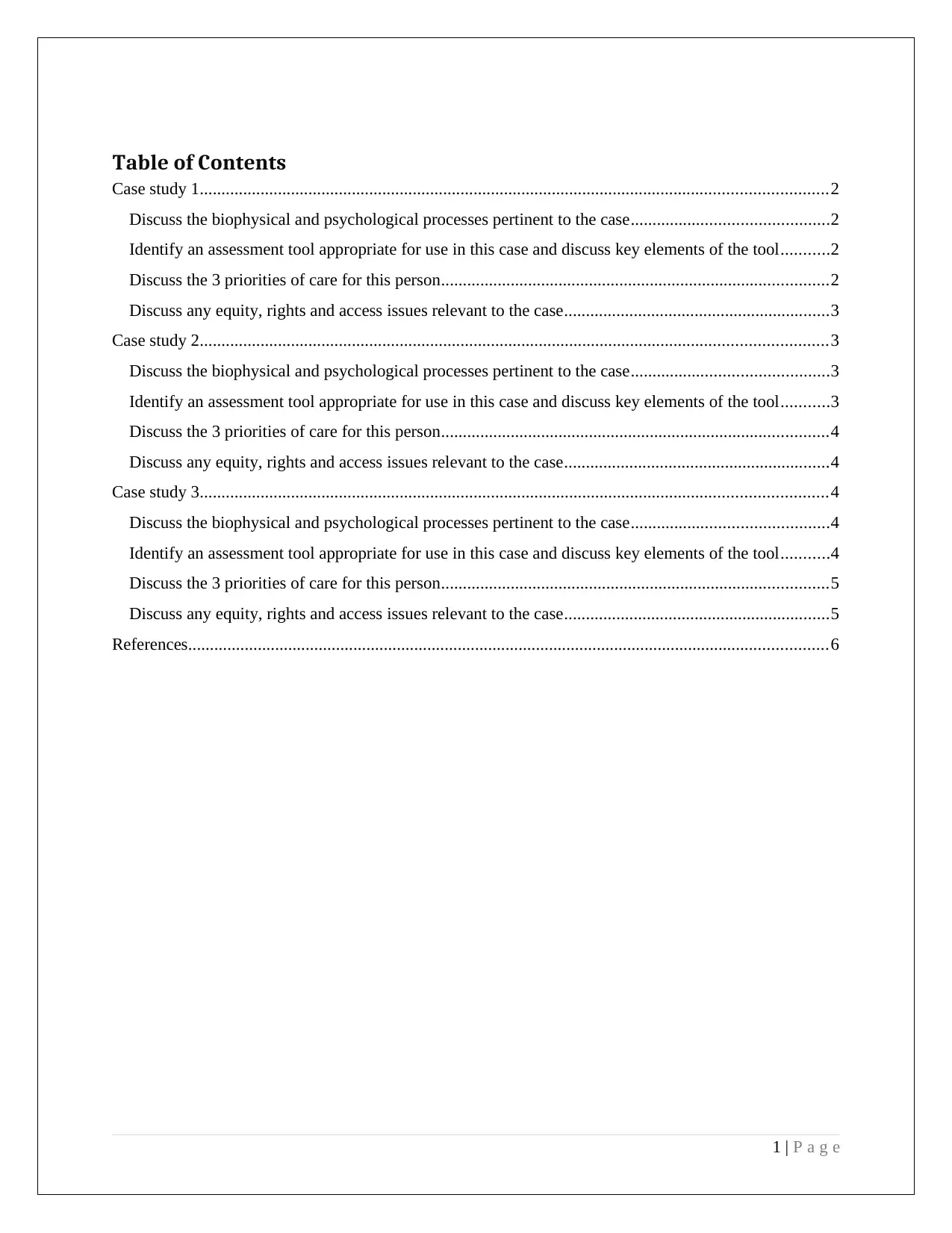
Table of Contents
Case study 1................................................................................................................................................2
Discuss the biophysical and psychological processes pertinent to the case.............................................2
Identify an assessment tool appropriate for use in this case and discuss key elements of the tool...........2
Discuss the 3 priorities of care for this person.........................................................................................2
Discuss any equity, rights and access issues relevant to the case.............................................................3
Case study 2................................................................................................................................................3
Discuss the biophysical and psychological processes pertinent to the case.............................................3
Identify an assessment tool appropriate for use in this case and discuss key elements of the tool...........3
Discuss the 3 priorities of care for this person.........................................................................................4
Discuss any equity, rights and access issues relevant to the case.............................................................4
Case study 3................................................................................................................................................4
Discuss the biophysical and psychological processes pertinent to the case.............................................4
Identify an assessment tool appropriate for use in this case and discuss key elements of the tool...........4
Discuss the 3 priorities of care for this person.........................................................................................5
Discuss any equity, rights and access issues relevant to the case.............................................................5
References...................................................................................................................................................6
1 | P a g e
Case study 1................................................................................................................................................2
Discuss the biophysical and psychological processes pertinent to the case.............................................2
Identify an assessment tool appropriate for use in this case and discuss key elements of the tool...........2
Discuss the 3 priorities of care for this person.........................................................................................2
Discuss any equity, rights and access issues relevant to the case.............................................................3
Case study 2................................................................................................................................................3
Discuss the biophysical and psychological processes pertinent to the case.............................................3
Identify an assessment tool appropriate for use in this case and discuss key elements of the tool...........3
Discuss the 3 priorities of care for this person.........................................................................................4
Discuss any equity, rights and access issues relevant to the case.............................................................4
Case study 3................................................................................................................................................4
Discuss the biophysical and psychological processes pertinent to the case.............................................4
Identify an assessment tool appropriate for use in this case and discuss key elements of the tool...........4
Discuss the 3 priorities of care for this person.........................................................................................5
Discuss any equity, rights and access issues relevant to the case.............................................................5
References...................................................................................................................................................6
1 | P a g e
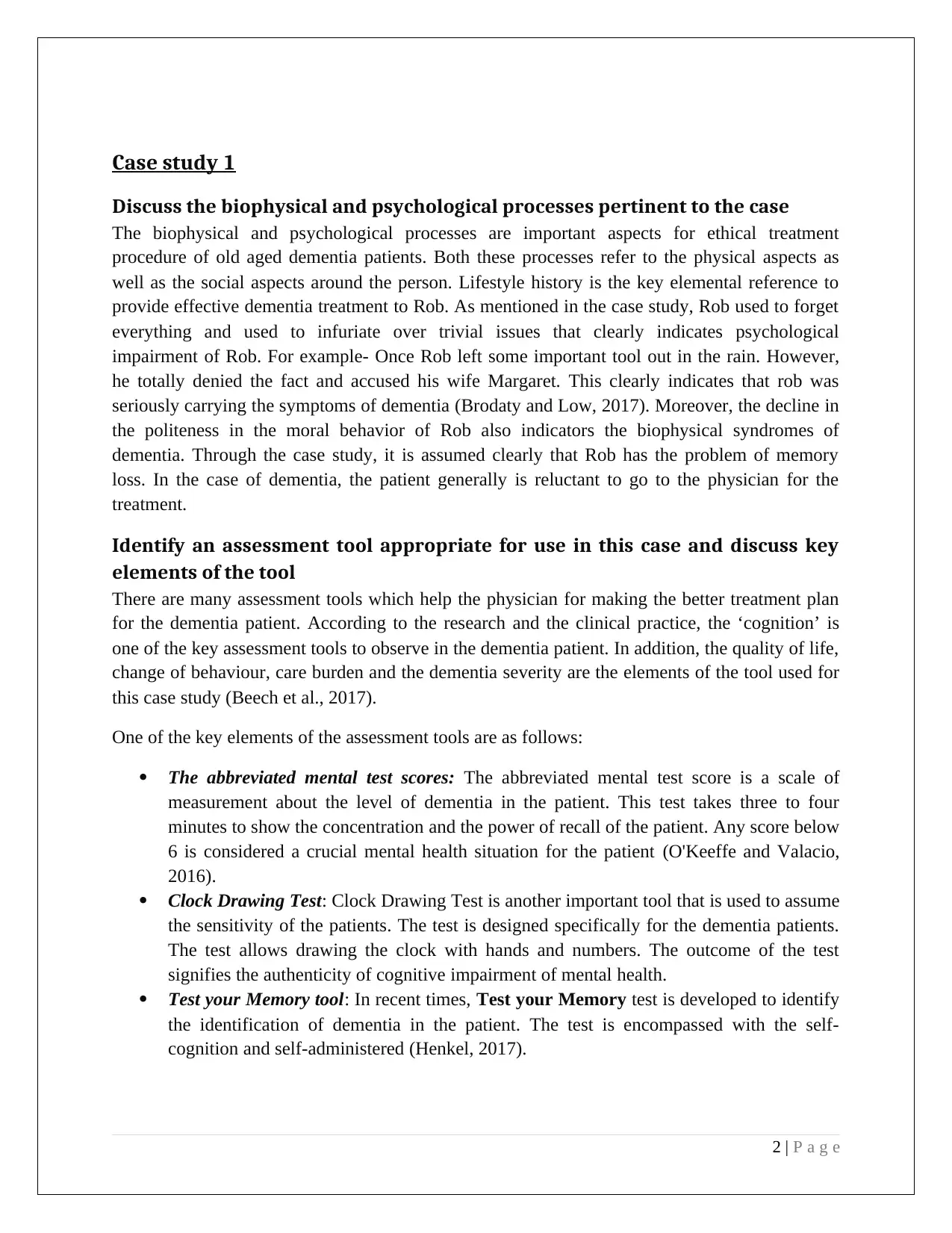
Case study 1
Discuss the biophysical and psychological processes pertinent to the case
The biophysical and psychological processes are important aspects for ethical treatment
procedure of old aged dementia patients. Both these processes refer to the physical aspects as
well as the social aspects around the person. Lifestyle history is the key elemental reference to
provide effective dementia treatment to Rob. As mentioned in the case study, Rob used to forget
everything and used to infuriate over trivial issues that clearly indicates psychological
impairment of Rob. For example- Once Rob left some important tool out in the rain. However,
he totally denied the fact and accused his wife Margaret. This clearly indicates that rob was
seriously carrying the symptoms of dementia (Brodaty and Low, 2017). Moreover, the decline in
the politeness in the moral behavior of Rob also indicators the biophysical syndromes of
dementia. Through the case study, it is assumed clearly that Rob has the problem of memory
loss. In the case of dementia, the patient generally is reluctant to go to the physician for the
treatment.
Identify an assessment tool appropriate for use in this case and discuss key
elements of the tool
There are many assessment tools which help the physician for making the better treatment plan
for the dementia patient. According to the research and the clinical practice, the ‘cognition’ is
one of the key assessment tools to observe in the dementia patient. In addition, the quality of life,
change of behaviour, care burden and the dementia severity are the elements of the tool used for
this case study (Beech et al., 2017).
One of the key elements of the assessment tools are as follows:
The abbreviated mental test scores: The abbreviated mental test score is a scale of
measurement about the level of dementia in the patient. This test takes three to four
minutes to show the concentration and the power of recall of the patient. Any score below
6 is considered a crucial mental health situation for the patient (O'Keeffe and Valacio,
2016).
Clock Drawing Test: Clock Drawing Test is another important tool that is used to assume
the sensitivity of the patients. The test is designed specifically for the dementia patients.
The test allows drawing the clock with hands and numbers. The outcome of the test
signifies the authenticity of cognitive impairment of mental health.
Test your Memory tool: In recent times, Test your Memory test is developed to identify
the identification of dementia in the patient. The test is encompassed with the self-
cognition and self-administered (Henkel, 2017).
2 | P a g e
Discuss the biophysical and psychological processes pertinent to the case
The biophysical and psychological processes are important aspects for ethical treatment
procedure of old aged dementia patients. Both these processes refer to the physical aspects as
well as the social aspects around the person. Lifestyle history is the key elemental reference to
provide effective dementia treatment to Rob. As mentioned in the case study, Rob used to forget
everything and used to infuriate over trivial issues that clearly indicates psychological
impairment of Rob. For example- Once Rob left some important tool out in the rain. However,
he totally denied the fact and accused his wife Margaret. This clearly indicates that rob was
seriously carrying the symptoms of dementia (Brodaty and Low, 2017). Moreover, the decline in
the politeness in the moral behavior of Rob also indicators the biophysical syndromes of
dementia. Through the case study, it is assumed clearly that Rob has the problem of memory
loss. In the case of dementia, the patient generally is reluctant to go to the physician for the
treatment.
Identify an assessment tool appropriate for use in this case and discuss key
elements of the tool
There are many assessment tools which help the physician for making the better treatment plan
for the dementia patient. According to the research and the clinical practice, the ‘cognition’ is
one of the key assessment tools to observe in the dementia patient. In addition, the quality of life,
change of behaviour, care burden and the dementia severity are the elements of the tool used for
this case study (Beech et al., 2017).
One of the key elements of the assessment tools are as follows:
The abbreviated mental test scores: The abbreviated mental test score is a scale of
measurement about the level of dementia in the patient. This test takes three to four
minutes to show the concentration and the power of recall of the patient. Any score below
6 is considered a crucial mental health situation for the patient (O'Keeffe and Valacio,
2016).
Clock Drawing Test: Clock Drawing Test is another important tool that is used to assume
the sensitivity of the patients. The test is designed specifically for the dementia patients.
The test allows drawing the clock with hands and numbers. The outcome of the test
signifies the authenticity of cognitive impairment of mental health.
Test your Memory tool: In recent times, Test your Memory test is developed to identify
the identification of dementia in the patient. The test is encompassed with the self-
cognition and self-administered (Henkel, 2017).
2 | P a g e
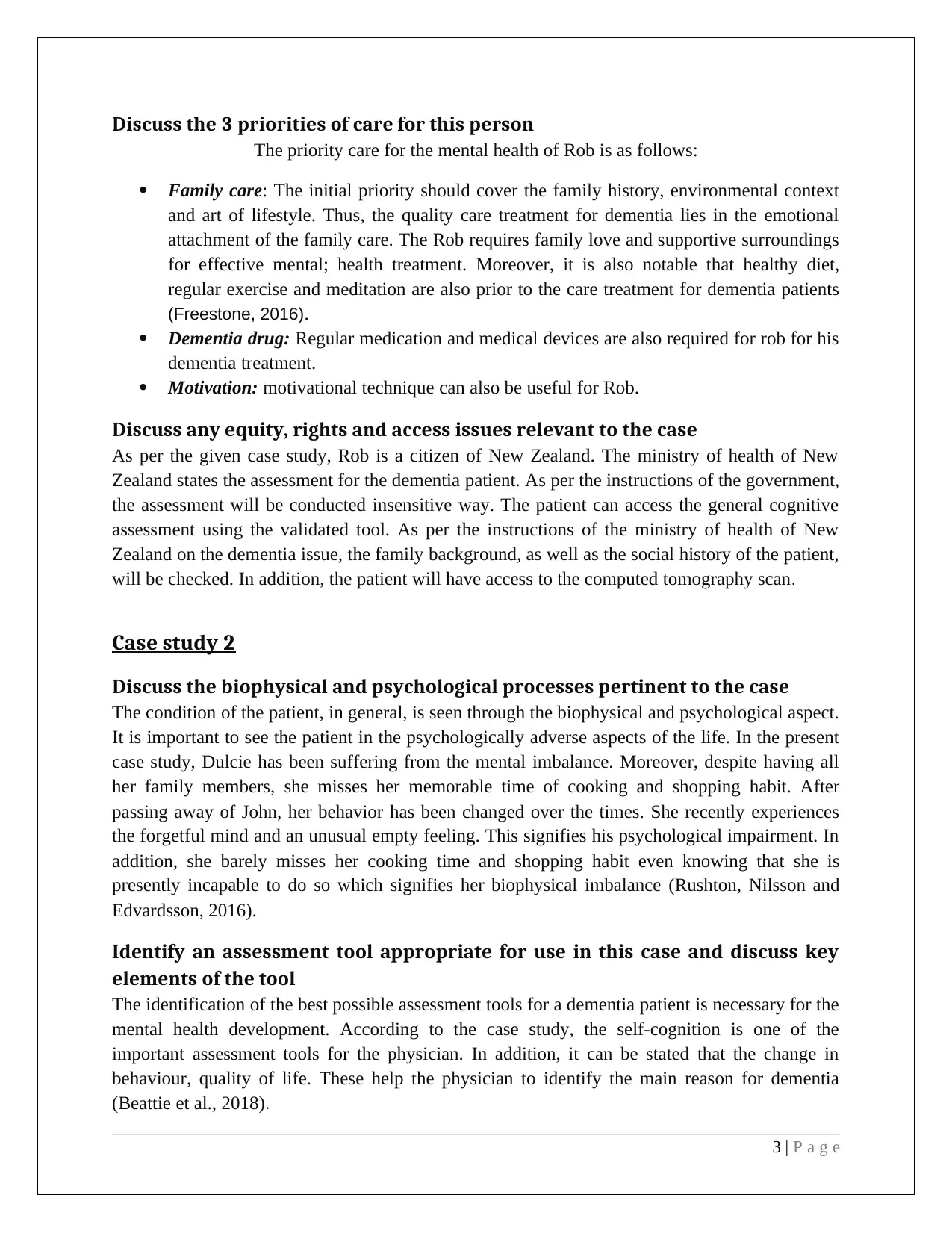
Discuss the 3 priorities of care for this person
The priority care for the mental health of Rob is as follows:
Family care: The initial priority should cover the family history, environmental context
and art of lifestyle. Thus, the quality care treatment for dementia lies in the emotional
attachment of the family care. The Rob requires family love and supportive surroundings
for effective mental; health treatment. Moreover, it is also notable that healthy diet,
regular exercise and meditation are also prior to the care treatment for dementia patients
(Freestone, 2016).
Dementia drug: Regular medication and medical devices are also required for rob for his
dementia treatment.
Motivation: motivational technique can also be useful for Rob.
Discuss any equity, rights and access issues relevant to the case
As per the given case study, Rob is a citizen of New Zealand. The ministry of health of New
Zealand states the assessment for the dementia patient. As per the instructions of the government,
the assessment will be conducted insensitive way. The patient can access the general cognitive
assessment using the validated tool. As per the instructions of the ministry of health of New
Zealand on the dementia issue, the family background, as well as the social history of the patient,
will be checked. In addition, the patient will have access to the computed tomography scan.
Case study 2
Discuss the biophysical and psychological processes pertinent to the case
The condition of the patient, in general, is seen through the biophysical and psychological aspect.
It is important to see the patient in the psychologically adverse aspects of the life. In the present
case study, Dulcie has been suffering from the mental imbalance. Moreover, despite having all
her family members, she misses her memorable time of cooking and shopping habit. After
passing away of John, her behavior has been changed over the times. She recently experiences
the forgetful mind and an unusual empty feeling. This signifies his psychological impairment. In
addition, she barely misses her cooking time and shopping habit even knowing that she is
presently incapable to do so which signifies her biophysical imbalance (Rushton, Nilsson and
Edvardsson, 2016).
Identify an assessment tool appropriate for use in this case and discuss key
elements of the tool
The identification of the best possible assessment tools for a dementia patient is necessary for the
mental health development. According to the case study, the self-cognition is one of the
important assessment tools for the physician. In addition, it can be stated that the change in
behaviour, quality of life. These help the physician to identify the main reason for dementia
(Beattie et al., 2018).
3 | P a g e
The priority care for the mental health of Rob is as follows:
Family care: The initial priority should cover the family history, environmental context
and art of lifestyle. Thus, the quality care treatment for dementia lies in the emotional
attachment of the family care. The Rob requires family love and supportive surroundings
for effective mental; health treatment. Moreover, it is also notable that healthy diet,
regular exercise and meditation are also prior to the care treatment for dementia patients
(Freestone, 2016).
Dementia drug: Regular medication and medical devices are also required for rob for his
dementia treatment.
Motivation: motivational technique can also be useful for Rob.
Discuss any equity, rights and access issues relevant to the case
As per the given case study, Rob is a citizen of New Zealand. The ministry of health of New
Zealand states the assessment for the dementia patient. As per the instructions of the government,
the assessment will be conducted insensitive way. The patient can access the general cognitive
assessment using the validated tool. As per the instructions of the ministry of health of New
Zealand on the dementia issue, the family background, as well as the social history of the patient,
will be checked. In addition, the patient will have access to the computed tomography scan.
Case study 2
Discuss the biophysical and psychological processes pertinent to the case
The condition of the patient, in general, is seen through the biophysical and psychological aspect.
It is important to see the patient in the psychologically adverse aspects of the life. In the present
case study, Dulcie has been suffering from the mental imbalance. Moreover, despite having all
her family members, she misses her memorable time of cooking and shopping habit. After
passing away of John, her behavior has been changed over the times. She recently experiences
the forgetful mind and an unusual empty feeling. This signifies his psychological impairment. In
addition, she barely misses her cooking time and shopping habit even knowing that she is
presently incapable to do so which signifies her biophysical imbalance (Rushton, Nilsson and
Edvardsson, 2016).
Identify an assessment tool appropriate for use in this case and discuss key
elements of the tool
The identification of the best possible assessment tools for a dementia patient is necessary for the
mental health development. According to the case study, the self-cognition is one of the
important assessment tools for the physician. In addition, it can be stated that the change in
behaviour, quality of life. These help the physician to identify the main reason for dementia
(Beattie et al., 2018).
3 | P a g e
Secure Best Marks with AI Grader
Need help grading? Try our AI Grader for instant feedback on your assignments.
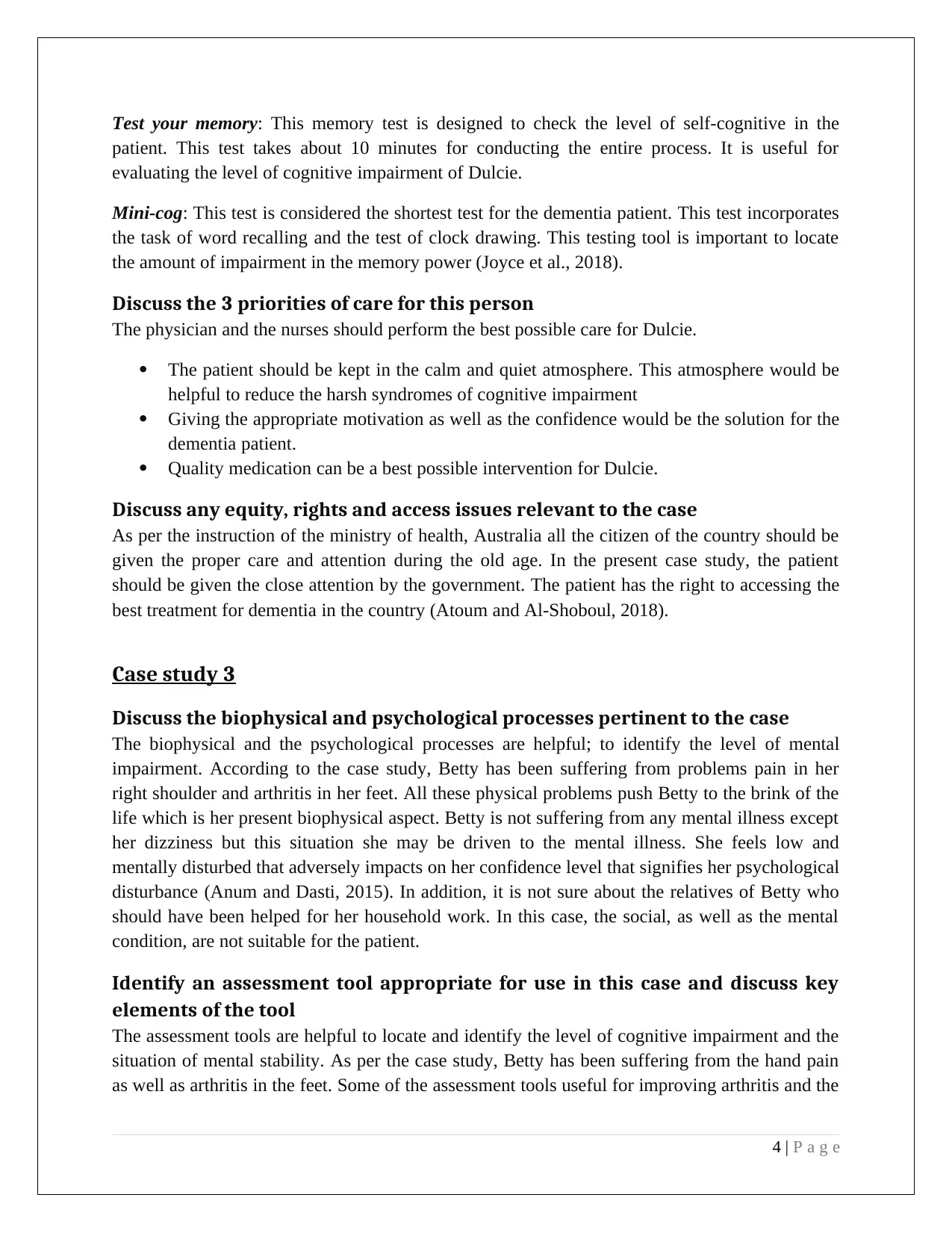
Test your memory: This memory test is designed to check the level of self-cognitive in the
patient. This test takes about 10 minutes for conducting the entire process. It is useful for
evaluating the level of cognitive impairment of Dulcie.
Mini-cog: This test is considered the shortest test for the dementia patient. This test incorporates
the task of word recalling and the test of clock drawing. This testing tool is important to locate
the amount of impairment in the memory power (Joyce et al., 2018).
Discuss the 3 priorities of care for this person
The physician and the nurses should perform the best possible care for Dulcie.
The patient should be kept in the calm and quiet atmosphere. This atmosphere would be
helpful to reduce the harsh syndromes of cognitive impairment
Giving the appropriate motivation as well as the confidence would be the solution for the
dementia patient.
Quality medication can be a best possible intervention for Dulcie.
Discuss any equity, rights and access issues relevant to the case
As per the instruction of the ministry of health, Australia all the citizen of the country should be
given the proper care and attention during the old age. In the present case study, the patient
should be given the close attention by the government. The patient has the right to accessing the
best treatment for dementia in the country (Atoum and Al-Shoboul, 2018).
Case study 3
Discuss the biophysical and psychological processes pertinent to the case
The biophysical and the psychological processes are helpful; to identify the level of mental
impairment. According to the case study, Betty has been suffering from problems pain in her
right shoulder and arthritis in her feet. All these physical problems push Betty to the brink of the
life which is her present biophysical aspect. Betty is not suffering from any mental illness except
her dizziness but this situation she may be driven to the mental illness. She feels low and
mentally disturbed that adversely impacts on her confidence level that signifies her psychological
disturbance (Anum and Dasti, 2015). In addition, it is not sure about the relatives of Betty who
should have been helped for her household work. In this case, the social, as well as the mental
condition, are not suitable for the patient.
Identify an assessment tool appropriate for use in this case and discuss key
elements of the tool
The assessment tools are helpful to locate and identify the level of cognitive impairment and the
situation of mental stability. As per the case study, Betty has been suffering from the hand pain
as well as arthritis in the feet. Some of the assessment tools useful for improving arthritis and the
4 | P a g e
patient. This test takes about 10 minutes for conducting the entire process. It is useful for
evaluating the level of cognitive impairment of Dulcie.
Mini-cog: This test is considered the shortest test for the dementia patient. This test incorporates
the task of word recalling and the test of clock drawing. This testing tool is important to locate
the amount of impairment in the memory power (Joyce et al., 2018).
Discuss the 3 priorities of care for this person
The physician and the nurses should perform the best possible care for Dulcie.
The patient should be kept in the calm and quiet atmosphere. This atmosphere would be
helpful to reduce the harsh syndromes of cognitive impairment
Giving the appropriate motivation as well as the confidence would be the solution for the
dementia patient.
Quality medication can be a best possible intervention for Dulcie.
Discuss any equity, rights and access issues relevant to the case
As per the instruction of the ministry of health, Australia all the citizen of the country should be
given the proper care and attention during the old age. In the present case study, the patient
should be given the close attention by the government. The patient has the right to accessing the
best treatment for dementia in the country (Atoum and Al-Shoboul, 2018).
Case study 3
Discuss the biophysical and psychological processes pertinent to the case
The biophysical and the psychological processes are helpful; to identify the level of mental
impairment. According to the case study, Betty has been suffering from problems pain in her
right shoulder and arthritis in her feet. All these physical problems push Betty to the brink of the
life which is her present biophysical aspect. Betty is not suffering from any mental illness except
her dizziness but this situation she may be driven to the mental illness. She feels low and
mentally disturbed that adversely impacts on her confidence level that signifies her psychological
disturbance (Anum and Dasti, 2015). In addition, it is not sure about the relatives of Betty who
should have been helped for her household work. In this case, the social, as well as the mental
condition, are not suitable for the patient.
Identify an assessment tool appropriate for use in this case and discuss key
elements of the tool
The assessment tools are helpful to locate and identify the level of cognitive impairment and the
situation of mental stability. As per the case study, Betty has been suffering from the hand pain
as well as arthritis in the feet. Some of the assessment tools useful for improving arthritis and the
4 | P a g e
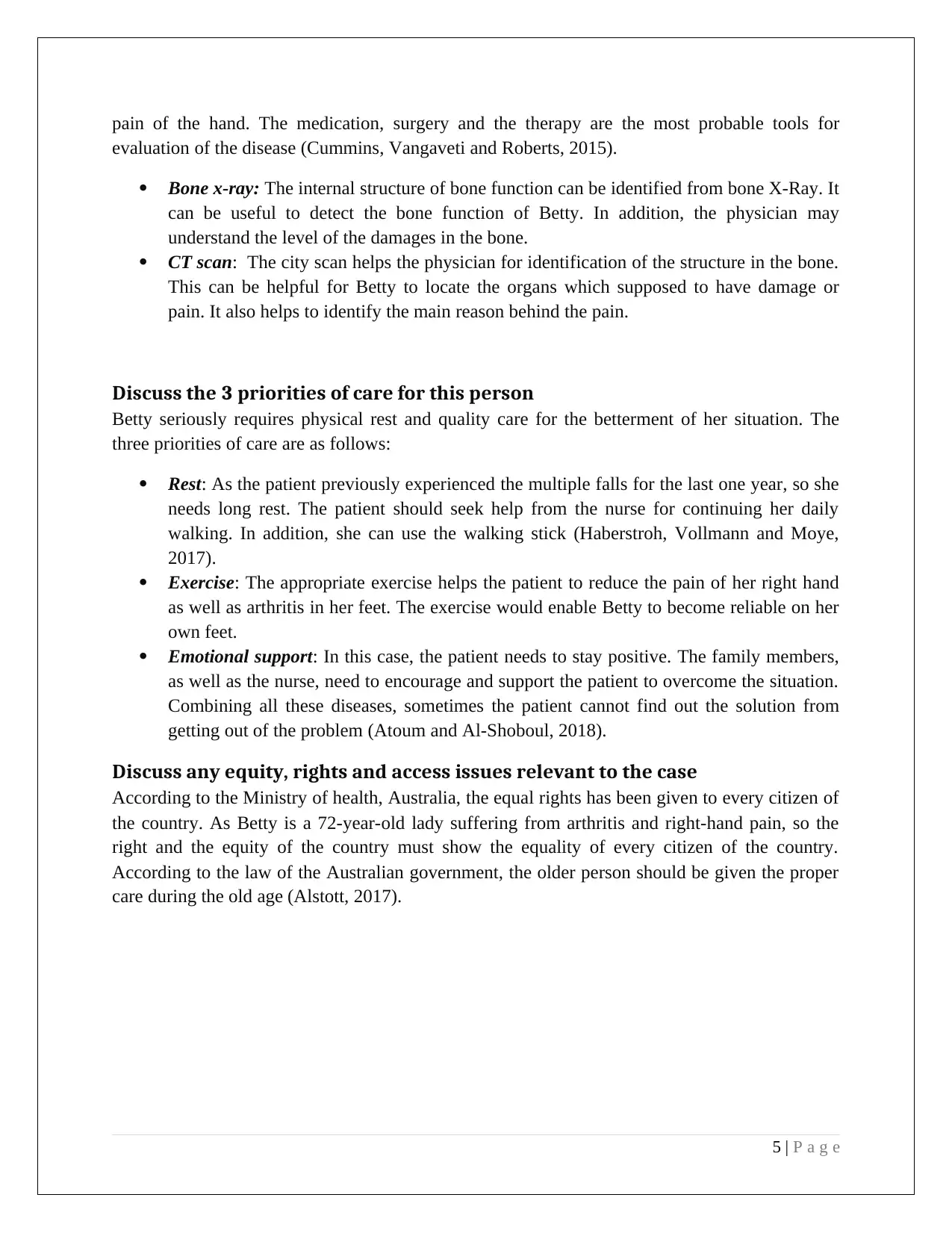
pain of the hand. The medication, surgery and the therapy are the most probable tools for
evaluation of the disease (Cummins, Vangaveti and Roberts, 2015).
Bone x-ray: The internal structure of bone function can be identified from bone X-Ray. It
can be useful to detect the bone function of Betty. In addition, the physician may
understand the level of the damages in the bone.
CT scan: The city scan helps the physician for identification of the structure in the bone.
This can be helpful for Betty to locate the organs which supposed to have damage or
pain. It also helps to identify the main reason behind the pain.
Discuss the 3 priorities of care for this person
Betty seriously requires physical rest and quality care for the betterment of her situation. The
three priorities of care are as follows:
Rest: As the patient previously experienced the multiple falls for the last one year, so she
needs long rest. The patient should seek help from the nurse for continuing her daily
walking. In addition, she can use the walking stick (Haberstroh, Vollmann and Moye,
2017).
Exercise: The appropriate exercise helps the patient to reduce the pain of her right hand
as well as arthritis in her feet. The exercise would enable Betty to become reliable on her
own feet.
Emotional support: In this case, the patient needs to stay positive. The family members,
as well as the nurse, need to encourage and support the patient to overcome the situation.
Combining all these diseases, sometimes the patient cannot find out the solution from
getting out of the problem (Atoum and Al-Shoboul, 2018).
Discuss any equity, rights and access issues relevant to the case
According to the Ministry of health, Australia, the equal rights has been given to every citizen of
the country. As Betty is a 72-year-old lady suffering from arthritis and right-hand pain, so the
right and the equity of the country must show the equality of every citizen of the country.
According to the law of the Australian government, the older person should be given the proper
care during the old age (Alstott, 2017).
5 | P a g e
evaluation of the disease (Cummins, Vangaveti and Roberts, 2015).
Bone x-ray: The internal structure of bone function can be identified from bone X-Ray. It
can be useful to detect the bone function of Betty. In addition, the physician may
understand the level of the damages in the bone.
CT scan: The city scan helps the physician for identification of the structure in the bone.
This can be helpful for Betty to locate the organs which supposed to have damage or
pain. It also helps to identify the main reason behind the pain.
Discuss the 3 priorities of care for this person
Betty seriously requires physical rest and quality care for the betterment of her situation. The
three priorities of care are as follows:
Rest: As the patient previously experienced the multiple falls for the last one year, so she
needs long rest. The patient should seek help from the nurse for continuing her daily
walking. In addition, she can use the walking stick (Haberstroh, Vollmann and Moye,
2017).
Exercise: The appropriate exercise helps the patient to reduce the pain of her right hand
as well as arthritis in her feet. The exercise would enable Betty to become reliable on her
own feet.
Emotional support: In this case, the patient needs to stay positive. The family members,
as well as the nurse, need to encourage and support the patient to overcome the situation.
Combining all these diseases, sometimes the patient cannot find out the solution from
getting out of the problem (Atoum and Al-Shoboul, 2018).
Discuss any equity, rights and access issues relevant to the case
According to the Ministry of health, Australia, the equal rights has been given to every citizen of
the country. As Betty is a 72-year-old lady suffering from arthritis and right-hand pain, so the
right and the equity of the country must show the equality of every citizen of the country.
According to the law of the Australian government, the older person should be given the proper
care during the old age (Alstott, 2017).
5 | P a g e
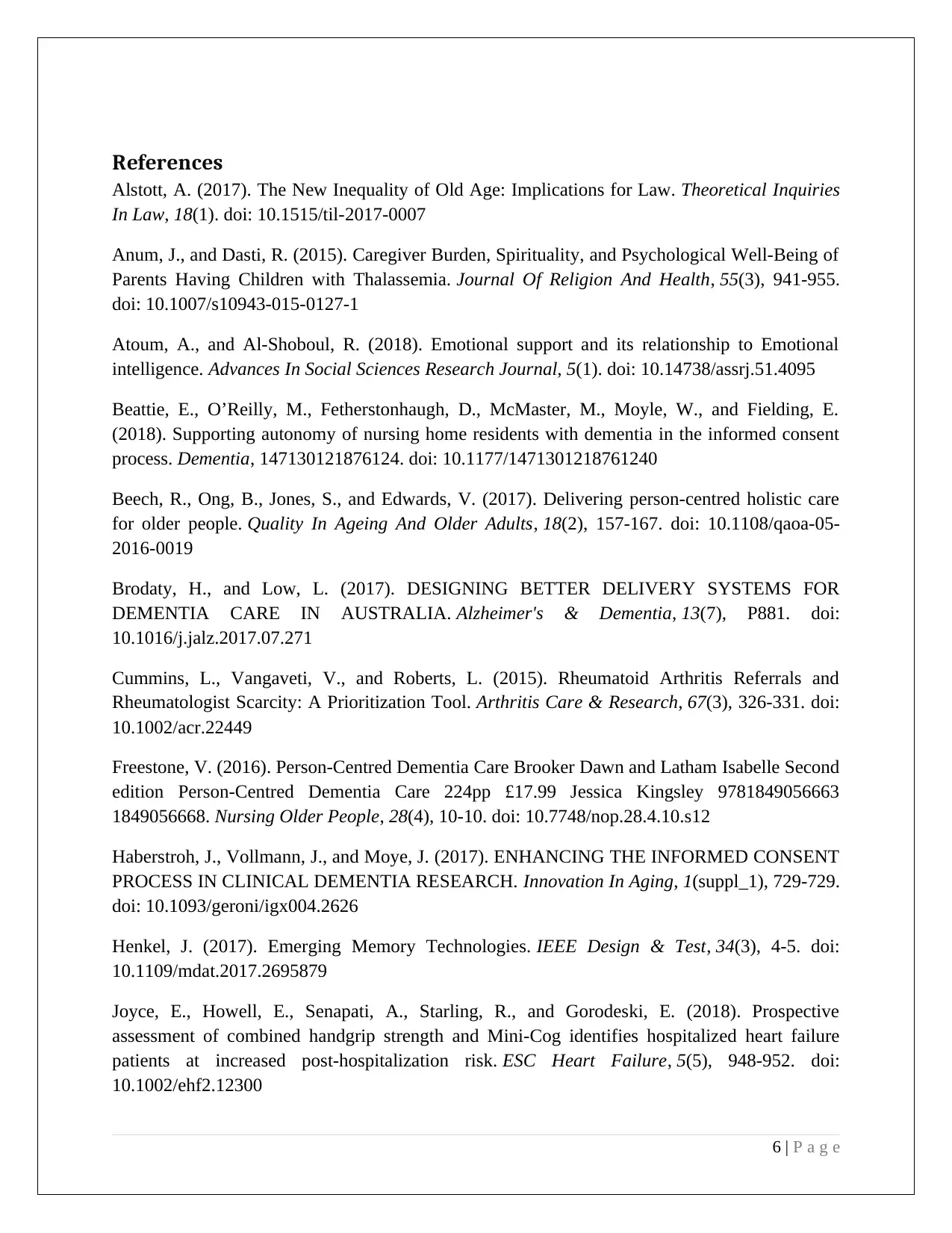
References
Alstott, A. (2017). The New Inequality of Old Age: Implications for Law. Theoretical Inquiries
In Law, 18(1). doi: 10.1515/til-2017-0007
Anum, J., and Dasti, R. (2015). Caregiver Burden, Spirituality, and Psychological Well-Being of
Parents Having Children with Thalassemia. Journal Of Religion And Health, 55(3), 941-955.
doi: 10.1007/s10943-015-0127-1
Atoum, A., and Al-Shoboul, R. (2018). Emotional support and its relationship to Emotional
intelligence. Advances In Social Sciences Research Journal, 5(1). doi: 10.14738/assrj.51.4095
Beattie, E., O’Reilly, M., Fetherstonhaugh, D., McMaster, M., Moyle, W., and Fielding, E.
(2018). Supporting autonomy of nursing home residents with dementia in the informed consent
process. Dementia, 147130121876124. doi: 10.1177/1471301218761240
Beech, R., Ong, B., Jones, S., and Edwards, V. (2017). Delivering person-centred holistic care
for older people. Quality In Ageing And Older Adults, 18(2), 157-167. doi: 10.1108/qaoa-05-
2016-0019
Brodaty, H., and Low, L. (2017). DESIGNING BETTER DELIVERY SYSTEMS FOR
DEMENTIA CARE IN AUSTRALIA. Alzheimer's & Dementia, 13(7), P881. doi:
10.1016/j.jalz.2017.07.271
Cummins, L., Vangaveti, V., and Roberts, L. (2015). Rheumatoid Arthritis Referrals and
Rheumatologist Scarcity: A Prioritization Tool. Arthritis Care & Research, 67(3), 326-331. doi:
10.1002/acr.22449
Freestone, V. (2016). Person-Centred Dementia Care Brooker Dawn and Latham Isabelle Second
edition Person-Centred Dementia Care 224pp £17.99 Jessica Kingsley 9781849056663
1849056668. Nursing Older People, 28(4), 10-10. doi: 10.7748/nop.28.4.10.s12
Haberstroh, J., Vollmann, J., and Moye, J. (2017). ENHANCING THE INFORMED CONSENT
PROCESS IN CLINICAL DEMENTIA RESEARCH. Innovation In Aging, 1(suppl_1), 729-729.
doi: 10.1093/geroni/igx004.2626
Henkel, J. (2017). Emerging Memory Technologies. IEEE Design & Test, 34(3), 4-5. doi:
10.1109/mdat.2017.2695879
Joyce, E., Howell, E., Senapati, A., Starling, R., and Gorodeski, E. (2018). Prospective
assessment of combined handgrip strength and Mini-Cog identifies hospitalized heart failure
patients at increased post-hospitalization risk. ESC Heart Failure, 5(5), 948-952. doi:
10.1002/ehf2.12300
6 | P a g e
Alstott, A. (2017). The New Inequality of Old Age: Implications for Law. Theoretical Inquiries
In Law, 18(1). doi: 10.1515/til-2017-0007
Anum, J., and Dasti, R. (2015). Caregiver Burden, Spirituality, and Psychological Well-Being of
Parents Having Children with Thalassemia. Journal Of Religion And Health, 55(3), 941-955.
doi: 10.1007/s10943-015-0127-1
Atoum, A., and Al-Shoboul, R. (2018). Emotional support and its relationship to Emotional
intelligence. Advances In Social Sciences Research Journal, 5(1). doi: 10.14738/assrj.51.4095
Beattie, E., O’Reilly, M., Fetherstonhaugh, D., McMaster, M., Moyle, W., and Fielding, E.
(2018). Supporting autonomy of nursing home residents with dementia in the informed consent
process. Dementia, 147130121876124. doi: 10.1177/1471301218761240
Beech, R., Ong, B., Jones, S., and Edwards, V. (2017). Delivering person-centred holistic care
for older people. Quality In Ageing And Older Adults, 18(2), 157-167. doi: 10.1108/qaoa-05-
2016-0019
Brodaty, H., and Low, L. (2017). DESIGNING BETTER DELIVERY SYSTEMS FOR
DEMENTIA CARE IN AUSTRALIA. Alzheimer's & Dementia, 13(7), P881. doi:
10.1016/j.jalz.2017.07.271
Cummins, L., Vangaveti, V., and Roberts, L. (2015). Rheumatoid Arthritis Referrals and
Rheumatologist Scarcity: A Prioritization Tool. Arthritis Care & Research, 67(3), 326-331. doi:
10.1002/acr.22449
Freestone, V. (2016). Person-Centred Dementia Care Brooker Dawn and Latham Isabelle Second
edition Person-Centred Dementia Care 224pp £17.99 Jessica Kingsley 9781849056663
1849056668. Nursing Older People, 28(4), 10-10. doi: 10.7748/nop.28.4.10.s12
Haberstroh, J., Vollmann, J., and Moye, J. (2017). ENHANCING THE INFORMED CONSENT
PROCESS IN CLINICAL DEMENTIA RESEARCH. Innovation In Aging, 1(suppl_1), 729-729.
doi: 10.1093/geroni/igx004.2626
Henkel, J. (2017). Emerging Memory Technologies. IEEE Design & Test, 34(3), 4-5. doi:
10.1109/mdat.2017.2695879
Joyce, E., Howell, E., Senapati, A., Starling, R., and Gorodeski, E. (2018). Prospective
assessment of combined handgrip strength and Mini-Cog identifies hospitalized heart failure
patients at increased post-hospitalization risk. ESC Heart Failure, 5(5), 948-952. doi:
10.1002/ehf2.12300
6 | P a g e
Paraphrase This Document
Need a fresh take? Get an instant paraphrase of this document with our AI Paraphraser

O'Keeffe, S., and Valacio, R. (2016). Prediction intervals to assess change in older patients using
the abbreviated mental test. Geriatrics & Gerontology International, 16(1), 148-149. doi:
10.1111/ggi.12515
Rushton, C., Nilsson, A., and Edvardsson, D. (2016). Reconciling concepts of time and person-
centred care of the older person with cognitive impairment in the acute care setting. Nursing
Philosophy, 17(4), 282-289. doi: 10.1111/nup.12132
7 | P a g e
the abbreviated mental test. Geriatrics & Gerontology International, 16(1), 148-149. doi:
10.1111/ggi.12515
Rushton, C., Nilsson, A., and Edvardsson, D. (2016). Reconciling concepts of time and person-
centred care of the older person with cognitive impairment in the acute care setting. Nursing
Philosophy, 17(4), 282-289. doi: 10.1111/nup.12132
7 | P a g e
1 out of 8
Related Documents
Your All-in-One AI-Powered Toolkit for Academic Success.
+13062052269
info@desklib.com
Available 24*7 on WhatsApp / Email
![[object Object]](/_next/static/media/star-bottom.7253800d.svg)
Unlock your academic potential
© 2024 | Zucol Services PVT LTD | All rights reserved.





